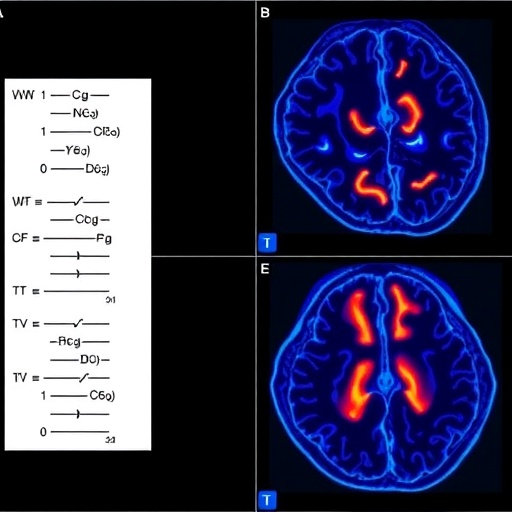In a groundbreaking study published in BMC Cancer, researchers have embarked on a comprehensive evaluation of CDKN2A gene deletions within diffuse gliomas through multiple detection platforms. The investigation targets a pivotal question in neuro-oncology: how best to accurately identify homozygous and heterozygous deletions of CDKN2A—a biomarker tightly linked with unfavorable prognosis in glioma patients. Amid the complexity of glioma genetics and diverse diagnostic technologies, this research offers fresh insights set to refine molecular diagnostics and potentially influence therapeutic strategies.
The CDKN2A gene encodes important tumor suppressor proteins that regulate the cell cycle, and its deletion is a common genetic aberration in various forms of cancer, particularly in diffuse gliomas. Detecting the status of CDKN2A—whether a partial (heterozygous) or full (homozygous) deletion—can dramatically affect clinical decision-making and prognosis estimation. Despite its clinical importance, standardized thresholds and detection practices have lagged behind, particularly with the most widely used method, fluorescent in situ hybridization (FISH).
This study retrospectively analyzed 100 formalin-fixed, paraffin-embedded glioma samples from patients, employing four different platforms: DNA-based next-generation sequencing (NGS), FISH, immunohistochemistry for p16 (IHC-p16), and IHC for methylthioadenosine phosphorylase (MTAP). By comparing the detection consistency and correlating findings across these distinct methodologies, the research significantly clarifies the diagnostic capabilities and limitations inherent in each approach.
Notably, the team reported a striking concordance between FISH and NGS results in identifying CDKN2A deletions. The calculated area under the curve (AUC) values reached 0.937 for homozygous deletion and an impressive 0.980 for overall deletion assessment, illuminating FISH’s viability as a rapid screening tool despite prior ambiguities. However, analysis underscored that no single platform could claim absolute superiority; each method exhibited unique strengths and shortcomings that must be considered in clinical contexts.
DNA-based NGS, renowned for its sensitivity and ability to comprehensively scan genetic alterations, provided a robust benchmark for deletion detection. Yet, the accessibility and cost of sequencing may limit its routine application. Conversely, immunohistochemistry for p16 and MTAP presents a simpler, more cost-effective strategy but demonstrated variability likely due to post-transcriptional modifications and protein degradation, complicating objective interpretation.
The researchers’ establishment of novel FISH cutoff values specifically tailored for CDKN2A deletion heralds a major advance in standardizing diagnostics. This enhancement could unify disparate laboratory practices, transitioning FISH from a purely qualitative to a more quantitative, reproducible assay. In doing so, it paves the way for broader and more confident implementation in pathology labs worldwide.
Beyond technical analyses, the study delved into the clinical implications of CDKN2A status, reaffirming its role as a critical prognostic indicator in diffuse gliomas regardless of IDH mutation status. Detecting deletions accurately could direct patient stratification in clinical trials and personalized treatment approaches, where targeted therapies might be optimized according to molecular profiles.
Underlying the investigation is a fundamental challenge in neurooncology: reconciling the complexity of glioma genetics with pragmatic, reliable diagnostic tests. The heterogeneity of gliomas, both molecularly and histologically, has historically complicated biomarker adoption in clinical practice. This research exemplifies how coordinated multi-platform evaluations can overcome such barriers by providing complementary data and reinforcing diagnostic confidence.
It is also essential to recognize the potential of the findings in catalyzing future studies. With standardized detection protocols for CDKN2A deletion now within reach, larger cohorts and prospective trials can verify and expand upon these results. Exploring correlations with therapeutic response and survival outcomes across diverse patient populations will be vital next steps.
Moreover, the methodological clarity furnished by this study may stimulate innovation in assay development. For instance, digital PCR techniques or novel immunoassays with enhanced specificity for CDKN2A-associated proteins could emerge, further enriching the diagnostic toolkit for neuro-oncologists.
In summary, this detailed assessment of CDKN2A deletions across multiple platforms constitutes a significant step toward precision medicine in glioma management. By illuminating the performance nuances of FISH, NGS, and immunohistochemical analyses, the study offers a well-rounded perspective on genetic evaluation standards that could ultimately improve patient care and prognostic accuracy.
Clinicians and researchers alike stand to benefit from this integrative approach, which highlights the importance of methodological rigor and cross-validation in molecular diagnostics. As neuro-oncology evolves, embracing such multi-faceted strategies will be key in unraveling the complexity of tumor biology and translating molecular insights into impactful therapies.
The study’s collaborative and retrospective design, involving 100 glioma cases, reinforces its relevance and applicability. This sizable sample, paired with the deployment of multiple diagnostic technologies, provides a robust dataset that strengthens conclusions and informs practical guidelines.
As glioma patients await improved prognostic tools and targeted treatments, advancements such as those detailed in this research represent hope and progress. Accurate detection of CDKN2A status could soon become an integral part of routine neuropathological assessment, guiding clinicians in designing optimal, individualized treatment regimens.
Ultimately, the thoughtful balance of technical depth and clinical focus in this study offers a model for future biomarker research, where multidisciplinary collaboration and innovative use of existing technologies drive meaningful change in cancer diagnostics.
Subject of Research: CDKN2A gene deletions in diffuse gliomas and their detection across multiple molecular and immunohistochemical platforms.
Article Title: Assessment of CDKN2A homozygous and heterozygous deletions in gliomas across multiple detection platforms.
Article References: Li, H., Luo, N., Fan, C. et al. Assessment of CDKN2A homozygous and heterozygous deletions in gliomas across multiple detection platforms. BMC Cancer 25, 1007 (2025). https://doi.org/10.1186/s12885-025-14266-x
Image Credits: Scienmag.com
DOI: https://doi.org/10.1186/s12885-025-14266-x




